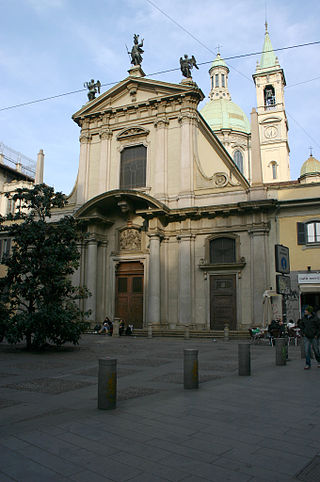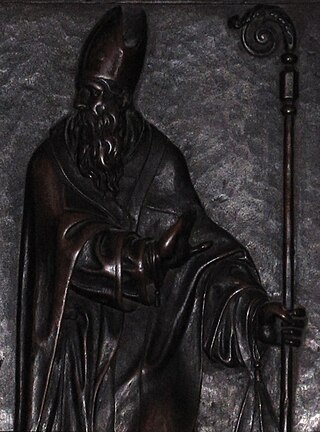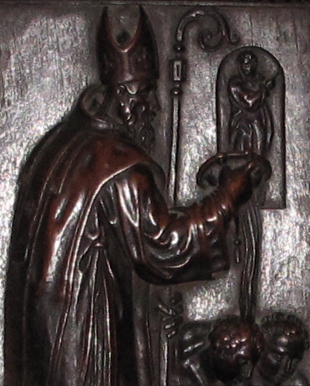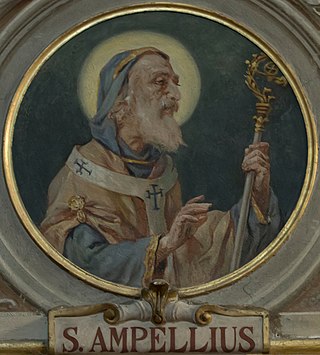Life
Natalis was in office as archbishop from 746 to 747, [2] but also the years 750 to 751 [3] or 740 to 741 are proposed by scholars.
Almost nothing is known about the life and the episcopate of Natalis. The main source of information about his episcopate was a gravestone which was placed in the church of San Giorgio al Palazzo in Milan and which was still extant in the 16th century. From the copies of such gravestone it is known that Natalis governed the church of Milan for fourteen months, that he died at 72 and that he founded the church of San Giorgio, having obtained a donation, probably from Ratchis, king of the Lombards. [2]
Other traditional information about his life, such as his surname Marinoni and his scholarship in Latin and Hebraic, have no historical basis. [3]
Natalis was buried in the nave of the church of San Giorgio al Palazzo. His relics were translated into the main altar of the same church in the 18th century by archbishop Giuseppe Pozzobonelli, and are still venerated there. [3] His feast day is 13 May in the Roman Rite and 9 May in the Ambrosian Rite. [4]

The Ambrosian Rite is a Latin liturgical rite of the Catholic Church. The rite is named after Saint Ambrose, a bishop of Milan in the fourth century. It is used by around five million Catholics in the greater part of the Archdiocese of Milan, in some parishes of the Diocese of Como, Bergamo, Novara, Lodi, and in the Diocese of Lugano, Canton of Ticino, Switzerland.

Simplician was Bishop of Milan from 397 to 400 or 401 AD. He is honoured as a Saint in the Roman Catholic and Eastern Orthodox Churches and his feast day is August 14.

San Giorgio al Palazzo is a baroque-style, Roman Catholic church in central Milan, region of Lombardy, Italy.

Benedict was Archbishop of Milan from c. 685–732. He is honoured as a saint in the Catholic and Eastern Orthodox Churches.

Glycerius was Archbishop of Milan from 436 to 438. He is honoured as a Saint in the Catholic Church and Eastern Orthodox Church.

Castritian was Bishop of Milan in mid 3rd-century. He is honoured as a Saint in the Catholic Church and his feast day is on December 1.

Monas was Bishop of Milan from the end 3rd-century to early 4th-century. He is honoured as a Saint in the Catholic Church and his feast day is on October 12.

Martinianus was Archbishop of Milan from 423 to 435. He is honoured as a Saint in the Catholic and Eastern Orthodox Churches. His feast day is 2 January.

Lazarus was Archbishop of Milan from 438 to 449 AD. He is honoured as a saint in the Catholic Church and his feast day is 11 February.

Gerontius was Archbishop of Milan from 462 to 465. He is honoured as a Saint in the Catholic Church and his feast day is 5 May.
Benignus was Archbishop of Milan from 465 to 472. He is honoured as a Saint in the Catholic Church and his feast day is September 20.

Protasius was Archbishop of Milan. He is honored as a saint in the Catholic Church, with his feast day celebrated on 24 November, the day of his death.

Caius was Bishop of Milan in early 3rd-century. He is considered by the Orthodox tradition the first Bishop of Milan in the 1st century. He is honoured as a saint in the Eastern Orthodox Church and the Roman Catholic Church and his feast day is on 27 September.

Anathalon was the first recorded Bishop of Milan and lived at the end 2nd-century or early 3rd-century. A later tradition made him the also the first bishop of Brescia. He is honoured as a saint in the Catholic and Eastern Orthodox Churches, which celebrate his feast day on 24 September. In Milan, however, this is commemorated on 25 September.

Theodorus I was Archbishop of Milan from 475 to 490. He is honoured as a saint in the Eastern Orthodox Church and Catholic Church, and his feast day is 27 July.
Lawrence I was Archbishop of Milan from 490 to c. 511. He is honoured as a saint in the Catholic Church and his feast day is July 25.

Magnus was Archbishop of Milan from 518 to c. 530. He is honoured as a saint in the Catholic Church and Orthodox Church.

John the Good, also known as John Camillus, was Archbishop of Milan from c. 641 to 669. He is honoured as a saint in the Eastern Orthodox Church and Roman Catholic Church.

Mansuetus was Archbishop of Milan from 676 to 685. He is honoured as a saint in the Catholic Church.

Ampelius was Archbishop of Milan from 671 to 676. He is honoured as a saint in the Catholic Church.
This page is based on this
Wikipedia article Text is available under the
CC BY-SA 4.0 license; additional terms may apply.
Images, videos and audio are available under their respective licenses.















